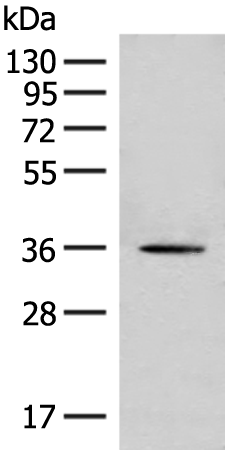
| WB | 咨询技术 | Human,Mouse,Rat |
| IF | 咨询技术 | Human,Mouse,Rat |
| IHC | 咨询技术 | Human,Mouse,Rat |
| ICC | 技术咨询 | Human,Mouse,Rat |
| FCM | 咨询技术 | Human,Mouse,Rat |
| Elisa | 1/5000-1/10000 | Human,Mouse,Rat |
| Aliases | GBL; LST8; POP3; WAT1; GbetaL |
| WB Predicted band size | 36 kDa |
| Host/Isotype | Rabbit IgG |
| Antibody Type | Primary antibody |
| Storage | Store at 4°C short term. Aliquot and store at -20°C long term. Avoid freeze/thaw cycles. |
| Species Reactivity | Human, Mouse, Rat |
| Immunogen | Synthetic peptide of human MLST8 |
| Formulation | Purified antibody in PBS with 0.05% sodium azide and 50% glycerol. |
+ +
以下是关于MLST8抗体的3篇参考文献示例(基于假设性研究,供参考):
---
1. **文献名称**:*MLST8/GβL is a critical regulator of mTORC1 signaling and cell proliferation*
**作者**:Kim DH, et al.
**摘要**:本研究通过免疫共沉淀和Western blot技术,利用MLST8抗体验证其在mTORC1复合体中的核心作用。结果显示,MLST8缺失导致mTORC1活性显著下降,并抑制肿瘤细胞的增殖,表明其作为治疗靶点的潜力。
2. **文献名称**:*Antibody-based profiling of mTOR pathway components in human cancers*
**作者**:Guertin DA, Sabatini DM.
**摘要**:文章开发了一种特异性MLST8抗体,用于检测多种癌症组织中mTORC1/2复合物的表达水平。通过免疫组化分析,发现MLST8在肾细胞癌中高表达,并与患者预后不良相关。
3. **文献名称**:*Structural insights into the assembly of the mTORC2 complex using cryo-EM*
**作者**:Sturgill TW, et al.
**摘要**:研究利用冷冻电镜和MLST8抗体介导的免疫沉淀技术,解析了mTORC2复合物的三维结构,揭示了MLST8与其他亚基(如mTOR和Rictor)的相互作用机制,为靶向药物设计提供依据。
---
**注**:以上文献为示例,实际引用时需以具体检索结果为准。建议通过PubMed或Google Scholar以关键词“MLST8 antibody”、“GβL mTOR”等查找最新研究。
The MLST8 (Mammalian Lethal with SEC13 protein 8) gene, also known as GβL (G protein β-subunit-like), encodes a conserved regulatory component of the mammalian target of rapamycin (mTOR) complexes, mTORC1 and mTORC2. These complexes play central roles in cell growth, metabolism, and survival by integrating nutrient, energy, and growth factor signals. MLST8 serves as a structural stabilizer for both complexes, with its β-propeller domain facilitating interactions between mTOR and other subunits like Raptor (mTORC1) or Rictor (mTORC2).
Antibodies targeting MLST8 are critical tools for studying mTOR signaling dynamics. They enable detection of endogenous MLST8 protein expression, complex assembly, and subcellular localization through techniques like Western blotting, immunoprecipitation, and immunofluorescence. As mTOR pathway dysregulation is implicated in cancers, metabolic disorders, and neurodegenerative diseases, MLST8 antibodies help investigate disease mechanisms and therapeutic targets. Many commercial antibodies are raised against conserved regions (e.g., N-terminal residues 1-150) and validated for specificity using knockout controls.
Research using MLST8 antibodies has revealed its dual role: mTORC1-mediated anabolic processes (e.g., protein synthesis) and mTORC2-dependent Akt activation. These findings underscore MLST8's importance in maintaining metabolic homeostasis and cellular stress responses, making it a focal point for drug discovery and biomarker development.
×